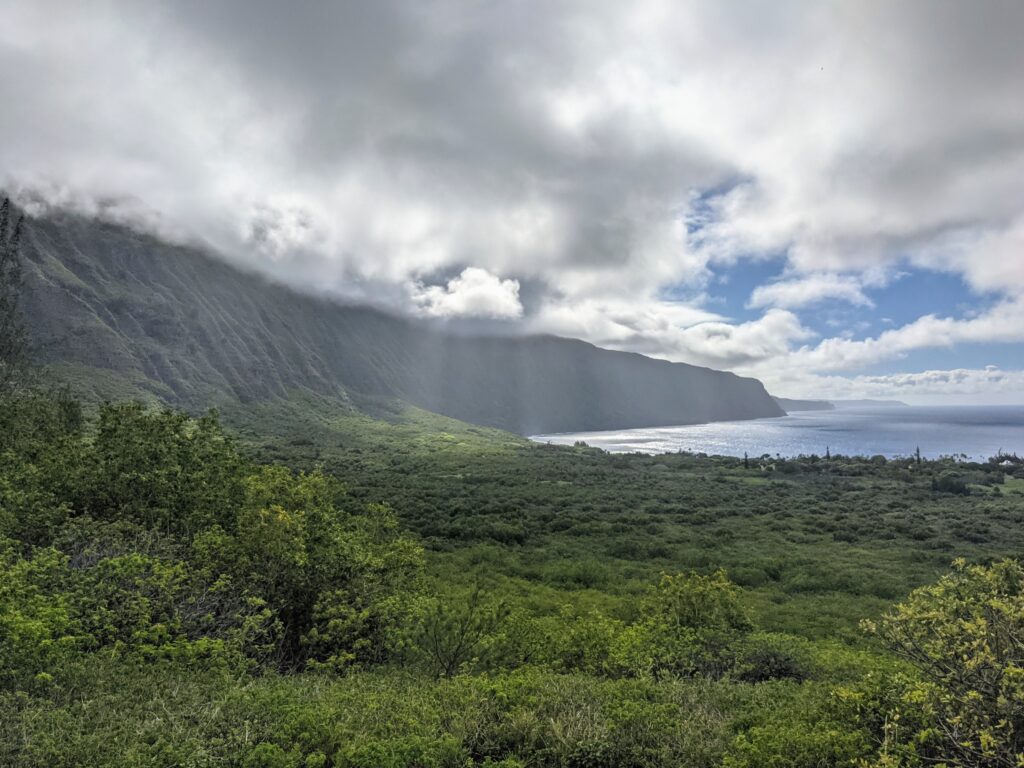
Two weeks into my stay at Kalaupapa National Historical Park, I had already trekked through the Hawaiian backcountry, participated in survey dives around the peninsula, and assisted with helicopter operations in the park (read about all of those adventures in my previous two posts). Little did I know at the time, that was only the beginning of my Kalaupapa experience. The initial plan was to spend three weeks in Kalaupapa and then travel to American Samoa for another three weeks. However, American Samoa was only just beginning to allow people on and off the island, and it seemed risky at best to board a flight there (I was told I may not be able to get out if the government changed travel regulations again).
Thankfully, Kelly Moore — park dive officer and marine ecologist — was able to finagle a few more weeks of housing for me in Kalaupapa. What was initially a three-week stay turned into a six-week stay — and it did not disappoint! I was lucky to participate in a number of projects that the Kalaupapa Natural Resources Division manages throughout the year: helping with the annual Barge Day, providing annual maintenance to the park’s weather monitoring station, surveying endangered Hawaiian monk seal populations, and even getting my Wilderness First Responder certification.
BARGE DAY
Barge Day is Kalaupapa’s “Christmas 2.0”. Once a year, a monstrous shipping barge arrives at the park, carrying an entire year’s worth of non-perishable goods, fuel, building supplies, vehicles, and other large pieces of cargo, appliances, and machinery. Barge Day was originally scheduled for the first Saturday I was in Kalaupapa, but weather and other logistical issues delayed the barge’s arrival until a few weeks into my stay. When we received word that the barge was, in fact, arriving after weeks of being postponed, a rush of anticipation and excitement filled the air. New cars, fresh crates of soda and beer, and materials for the construction of a new dive locker were on the way!
On the morning of Barge Day, I biked across town to the natural resources office, energized and eager to witness the barge’s arrival. I noticed that sections of the road had been blocked off and residents had placed camping chairs out along the shoreline so they could watch as the huge vessel slowly made its way to the settlement. What started as a speck on the horizon eventually grew into the clear outline of a barge, and after a few hours, it was docked and ready to be unloaded.
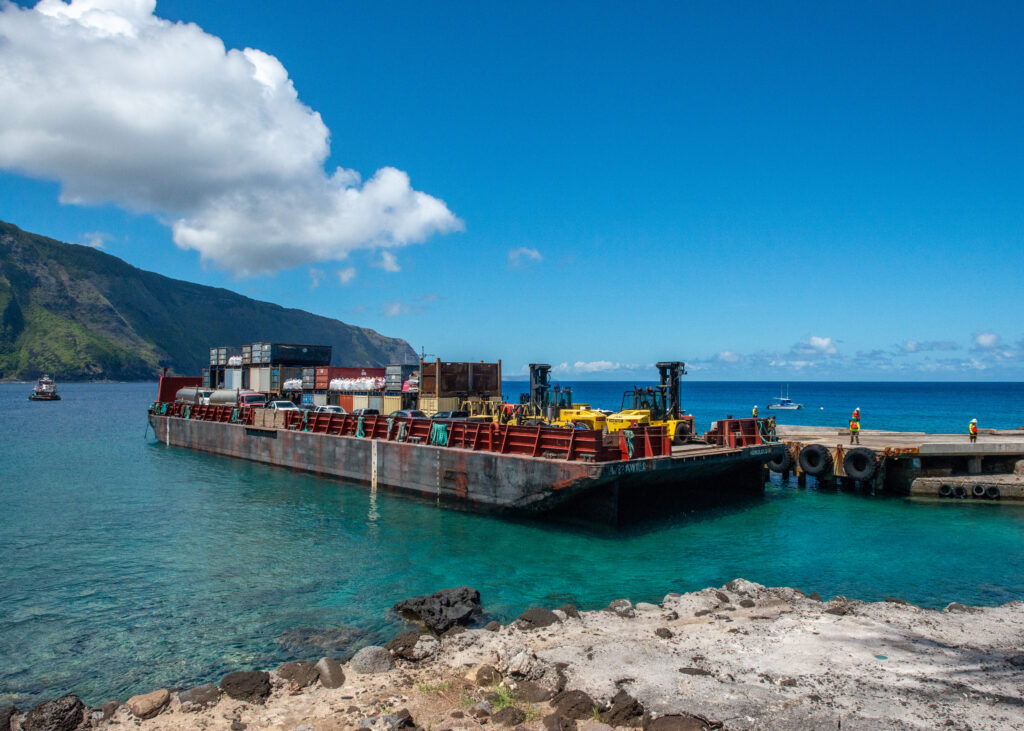
The barge delivers crates, shipping containers, and boxes of non-perishable goods and materials, along with new cars and other pieces of machinery that are used in the park.
Unloading quickly began, and the settlement turned into a bustling hive of activity. Workers on forklifts zoomed around, dropping containers, pallets, and boxes along the side of the road for inspection. Kelly and I volunteered to help with inventory checks, so our tasks involved identifying each order and confirming that the correct type and quantity of each item made it to the settlement. We stayed busy for most of the afternoon, but got to enjoy some special treats throughout the day, like shaved ice and a delicious lunch. All in all, it was a fun community event to be involved in, and I was particularly happy to meet some of the residents that I had yet to interact with. It seemed like everyone came out to witness the event!
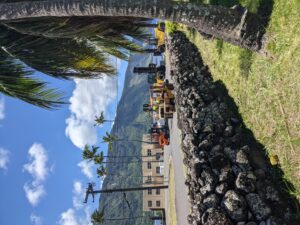
A pack of forklift operators gather, ready to move the next pile of unloaded goods.
WEATHER STATION MAINTENANCE
Average temperatures on the Pacific Islands are on the rise, and Hawaii has experienced a statewide decline in rainfall over the past two decades that is predicted to continue. Such climate projections come from models that are developed from existing weather data. All Pacific Island Network (PACN) parks have weather stations to help facilitate real-time tracking of weather conditions and provide data for climate modelers.
One of Kalaupapa’s weather stations is on the east side of the peninsula in Makapulapai, just off a dirt road that runs along the coast. The tower of weather instruments and wires stands tall in a brush-filled field with the cliffside in the background. On the station is an anemometer to measure wind speed/direction, a rain collection vessel to measure precipitation, and other sensors to quantify relative humidity, solar radiation, and temperature among other parameters. One morning, Glauco, Kelly, and I packed up the truck and drove across the peninsula to do annual maintenance on the station.
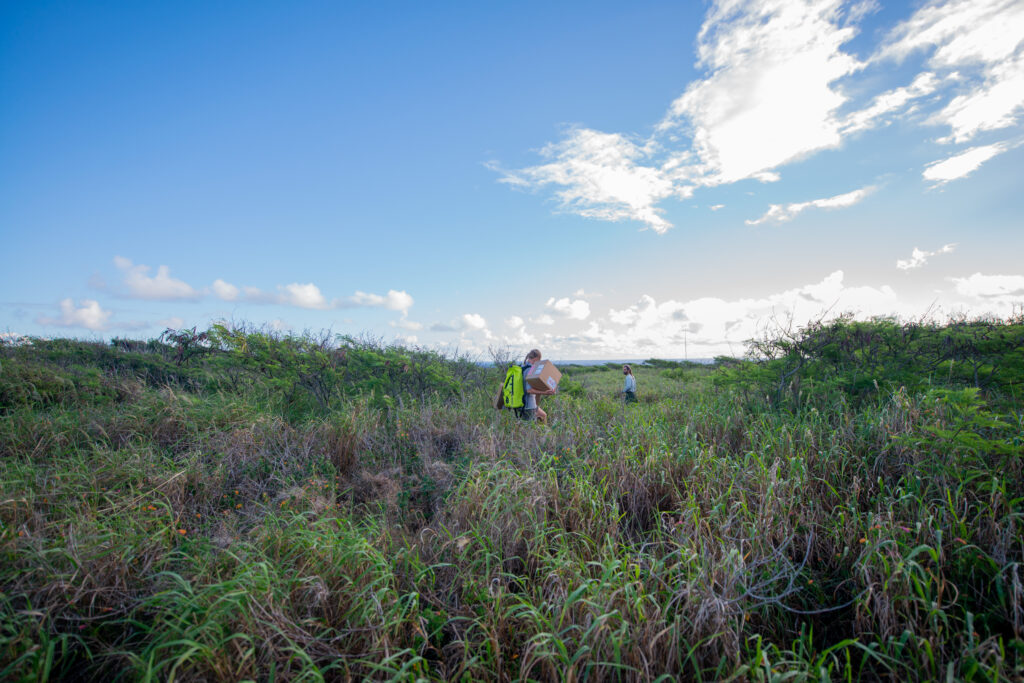
Kelly and Glauco trek through the bushes to reach the weather station.
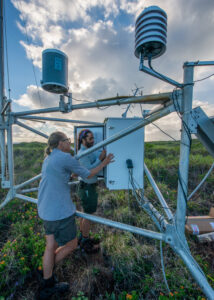
Inside the weather station’s control panel is a computer that stores all the data collected by the station’s many instruments.
Tagging along for some of the land-based work that Kelly and Glauco conducted in Kalaupapa provided a lot of insight into just how many ways natural resources are monitored, surveyed, and managed within the park. Marine fish surveys are equally as important as freshwater invertebrate surveys, and monitoring the monk seal population in the park is just as valuable as monitoring the park’s weather trends. To truly gain a comprehensive picture of the state of Kalaupapa’s natural resources (or any ecosystem), one must consider the interconnected nature of ecosystems. By assessing as many ecosystem components as possible, we come closer to better understanding the many ecological relationships at play and the inevitable impacts of ecological change
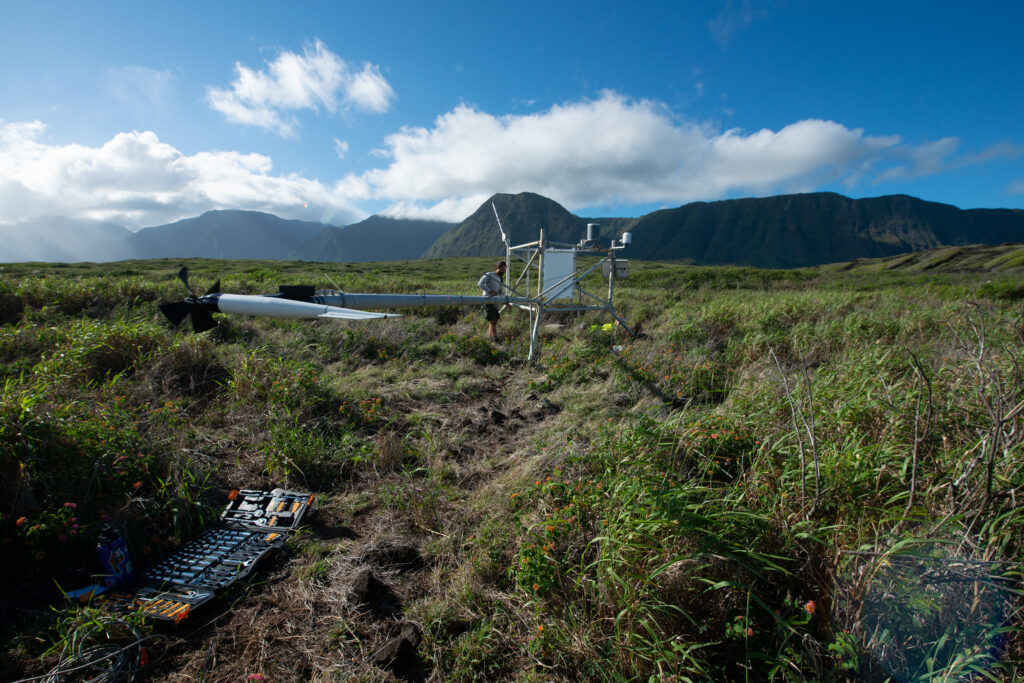
After extracting the data and doing a system update, we needed to change out some parts. The tall tower on the station can be lowered to make for easy maintenance.
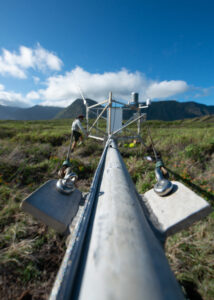
Glauco runs a new wire down to the tower’s control panel.
SEAL SEARCHING
There’s always that one character in an animated children’s movie that’s undeniably adorable (think minions from Despicable Me). They always have huge eyes and chubby cheeks and are usually made into stuffed animals because every small child wants to hug them (and because of consumerism, but that’s a different topic). Well, Hawaiian monk seals are Kalaupapa’s version of that movie character.
Hawaiian monk seals are one of the most endangered seal species in the world. Endemic to the Hawaiian islands, the doe-eyed marine mammals are heavily protected by Hawaiian state laws, the Endangered Species Act, and the Marine Mammals Protection Act. Many of them make their way to the beaches of Kalaupapa NHP each year to pup and haul out (i.e. rest), and oftentimes the pups will return once they’ve matured. NPS and NOAA work together to monitor the seals, track and record new births, and vaccinate the seals against morbillivirus — a virus similar to canine distemper.
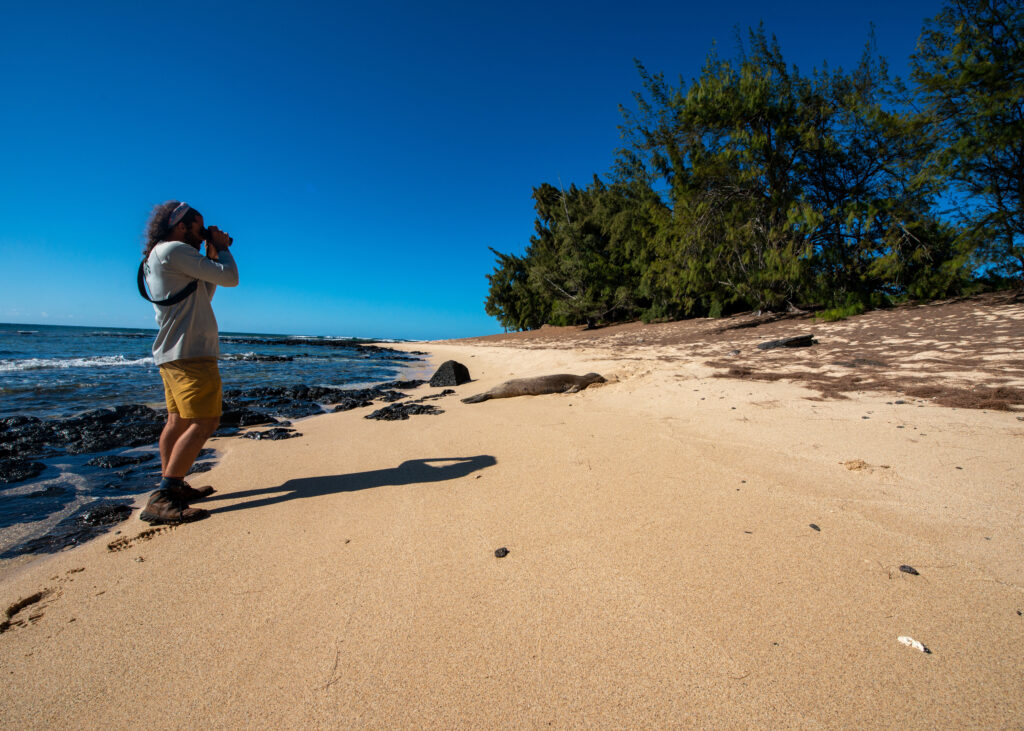
Glauco uses binoculars to read the ID tag on the fin of a sleeping monk seal. Monitoring and photos were conducted under NMFS Permit #22677.
I joined Glauco and Kelly on seal monitoring beach walks a few times during my visit to Kalaupapa. During my first one, I struggled to spot the seals as they lay stretched out and sleeping on the beach. From a distance, they look a lot like rocks. Over time, I became better at distinguishing their unique shape and light gray stomachs from afar. We walked along the beach, keeping our eyes peeled for seals. If we spotted one, the next step was to identify the seal and see if they needed vaccinations. Monk seal pups don’t have antibodies to protect them against morbillivirus, so pups are vaccinated in an attempt to prevent the disease from spreading and having substantial impacts on the population.
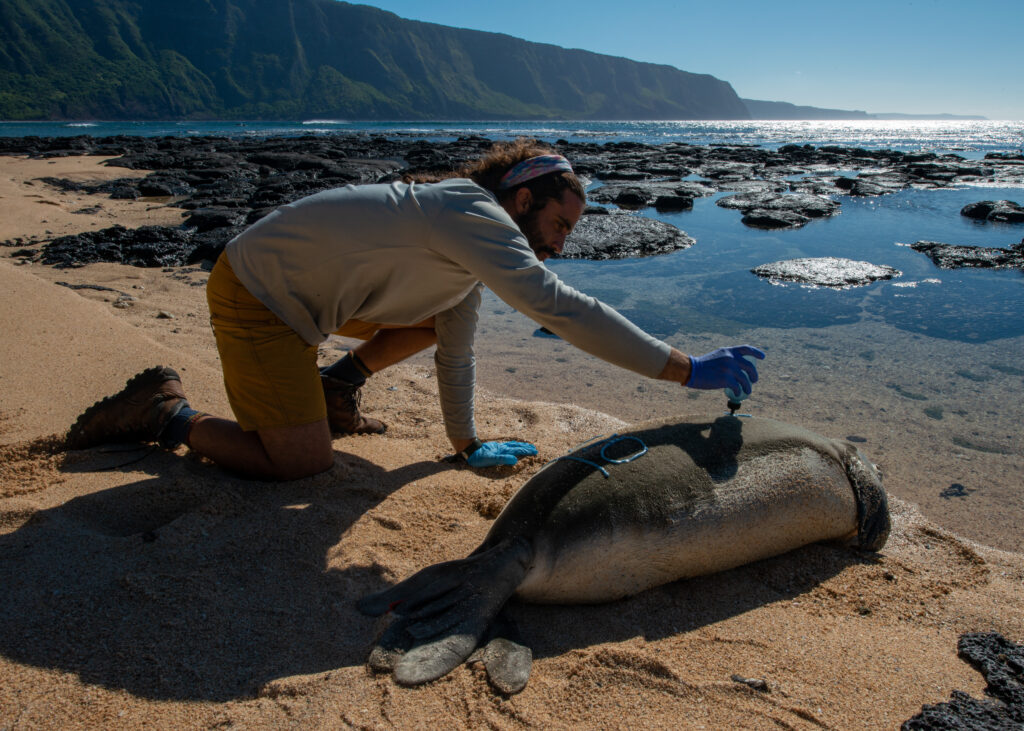
Glauco uses a commercial hair lightener to write a seal’s ID number on its back. This makes for easier identification in the future. Monitoring and photos were conducted under NMFS Permit #22677.
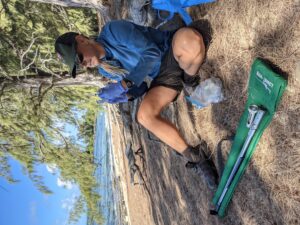
Here, Kelly preps a vaccine syringe, which is administered from a distance using a tranquilizer pole.
These seal monitoring and management efforts are part of NOAA’s Hawaiian Monk Seal Recovery Plan, which aims to conserve monk seal habitat, reduce mortality factors such as disease, develop education and outreach programs focused on minimizing human disturbances, and facilitate seal monitoring during pupping and hauling out events. With only an estimated 1,400 individuals in the population, there is concern about whether the genetic diversity of the population can be maintained in the long term. Hopefully, the efforts of NOAA, NPS, and other partnering organizations will help assure the long-term viability of the monk seal species in the wild.
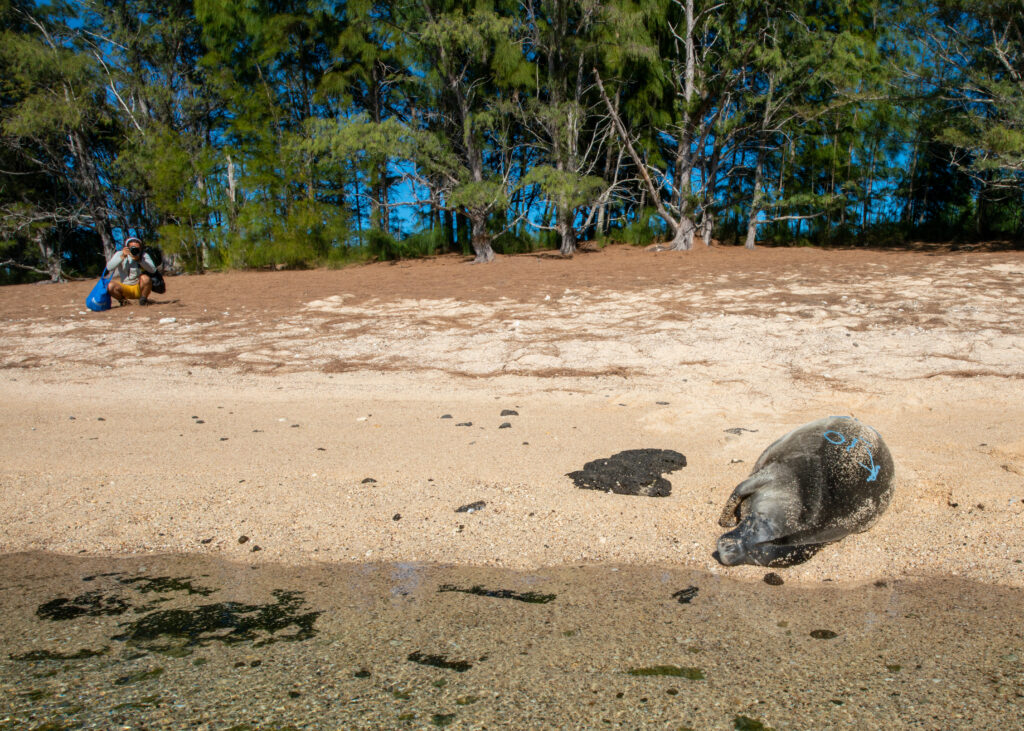
Most of the seals were heavy sleepers. We could ID them, photograph them, and apply the hair lightener without them waking up. We just had to cross our fingers that they wouldn’t roll over on their backs before the hair lightener had taken effect. Monitoring and photos were conducted under NMFS Permit #22677.
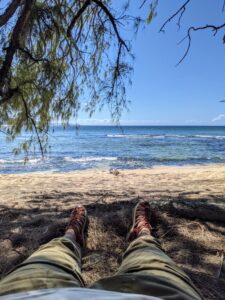
When doing monk seal surveys, it was important to keep a distance and avoid disturbing the animals. If the seals are severely frightened, they may not return to the area. Monitoring and photos were conducted under NMFS Permit #2267.
Knowing that there was so much marine life and activity going on underwater motivated me to snorkel and free dive as much as I could in the evenings and on the weekends. Camera rig and snorkel gear in hand, I’d jump into the water and venture out to see what was going on under the waves. I hoped to see one of the seals underwater and get some photos (from a safe distance), but it seemed like every time I had the camera with me the seals were nowhere to be found. Still, I’d stay busy taking photos of rays, lobsters, and the colorful corals scattered across the reef.
On one of my last days in Kalaupapa, I was swimming back to the wharf after snorkeling for a while and saw a grey figure move swiftly out of the corner of my eye. After weeks of snorkeling around Kalaupapa, I found myself underwater with a monk seal! The encounter was short-lived, but I quickly held up my camera to take a photo of it in the distance. The seal was gone before I knew it, although I immediately checked my camera and found that I had taken one single photo of it looking at me. I’m no wildlife photographer, but the experience made my day after so many weeks of wondering if I would have such an encounter.
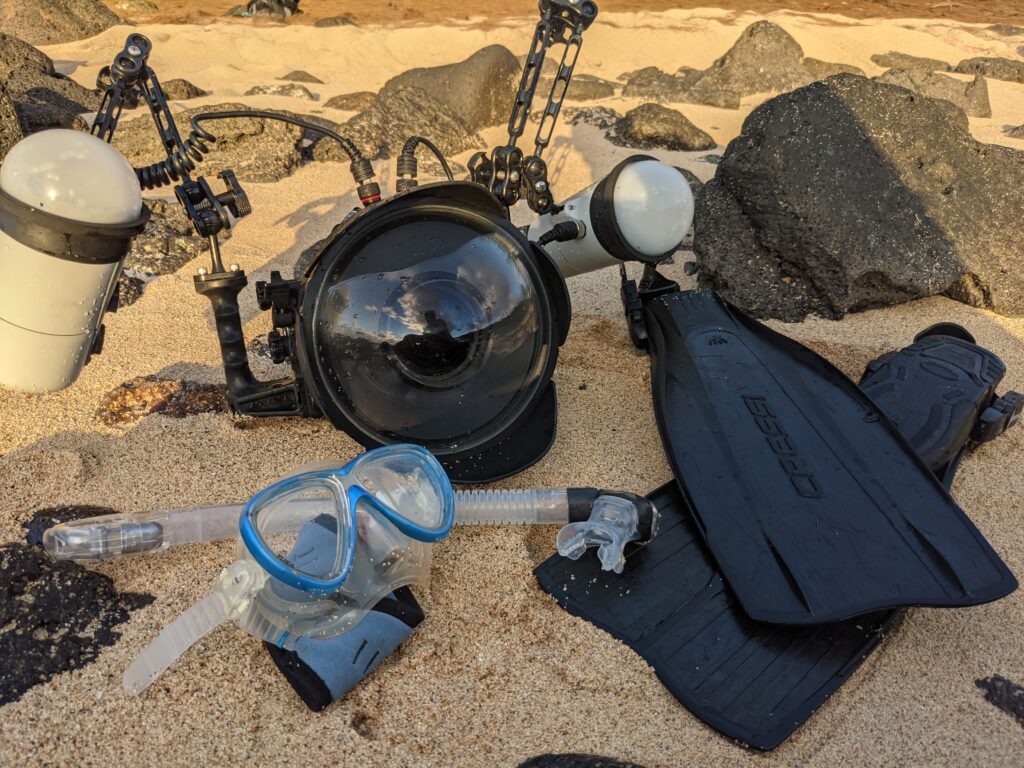 Lots of my evenings in Kalaupapa were spent enjoying the sunset from the beach and snorkeling with the camera.
Lots of my evenings in Kalaupapa were spent enjoying the sunset from the beach and snorkeling with the camera.
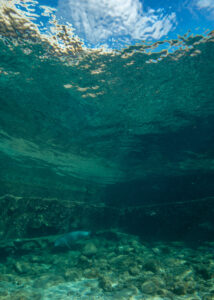
Can you see it? A monk seal cautiously swims by me in the Kalaupapa wharf.
WILDERNESS FIRST RESPONDER
One of the most exciting parts of my time in Kalaupapa was getting my Wilderness First Responder (WFR) certification. The WFR course provides definitive medical training for those who work or recreate in remote, low-resource outdoor environments — and Kalaupapa is the epitome of such an environment. Kelly organized for a WFR instructor to come to the settlement and teach the course to about a dozen NPS and DOH employees, and I was lucky to jump in and take the course as well.
During my last 10 days in Kalaupapa, my coworkers and I learned how to handle a plethora of medical scenarios, from minor health issues to life-threatening medical emergencies. Someone’s blood sugar crashed while they were hiking? Solved with fast-absorbing sugar, fluids, and calories. Someone was in a car crash and fractured their femur? Time to make a traction splint and get them to the hospital ASAP. We covered snake bites, hypothermia, heart attacks, heat stroke, you name it. Each day involved hours of classroom lectures with hands-on exercises and surprise scenarios mixed in throughout the day. We never knew when we would hear someone yelling outside and have to grab our backpacks, rush outdoors, assess the scene, and put the skills we were learning in class to the test. Matt May, owner of 4Points Expeditions and our WFR instructor, brought along bruise paint and stick on wounds to make the scenarios slightly more realistic. Acting ability was a huge component of making a practice scenario realistic, too. In retrospect, I got as much practice keeping a straight face during scenarios as I did learning to tie splints and wrap bandages correctly — and I’m definitely better at tying splints.
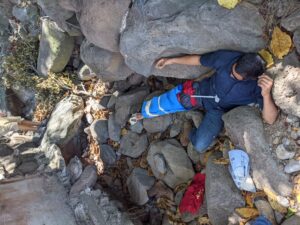
A scenario victim waiting for extraction. If someone has a fractured femur, they won’t be doing any walking out of the accident scene.
On the last day of the WFR course we had our final scenario. Matt recruited community members to help him stage an accident scene somewhere on the peninsula, and our crew was told to open an envelope in the classroom at exactly 18:00 (doing the scenario in the dark made for an added challenge). Everyone paced around nervously in the minutes leading up to the big reveal, backpacks and headlamps at the ready. When it was time, we opened the envelope and read the scenario: two hikers had been reported missing after not returning from a day hike on the east side of the peninsula. We needed to conduct a search, locate the individuals, and provide any care they may require.
The operation went off without a hitch. We drove to the area where the hikers were last seen, conducted a search, and located the injured victims (plot twist — there ended up being five). Matt forewarned us that the final scenario could take hours for groups to complete, but in less than two hours we had extracted all the victims and were back at the cars. To our delight, Matt told us that we were one of the best groups he’d worked with. Go team NPS and DOH!
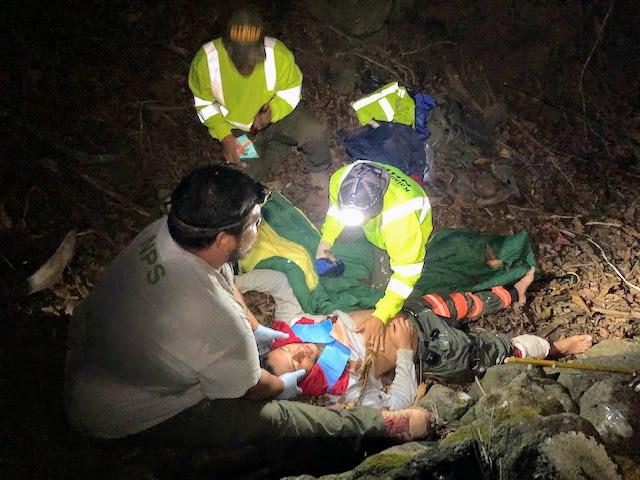
Teamwork is critical when handling emergency medical situations in the remote backcountry. In this case, there was one person to record notes, one to hold the victim’s head (in case of spinal injury), and one to see to the victim’s injuries.
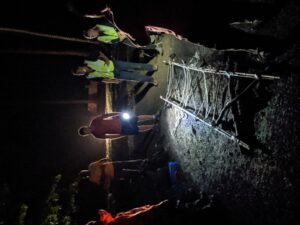
Matt (center) assesses the well-crafted litter that our crew built during the final WFR course scenario.
SAYING FAREWELL
I’ve struggled to write something that fully encapsulates my six weeks in Kalaupapa. Like all national parks, Kalaupapa NHP has an incredible story behind it — a story of resilience, perseverance, and the power of the human spirit. This place, which was once overshadowed by dark realities of exile and disease, now serves as a site for preservation, education, and refuge for those who have called the peninsula home for decades. Living there demands reflection — for the challenges that come with living there today are nothing in comparison to what those who lived there before endured.
I learned a lot about myself in the last six weeks, and I learned even more about community. My fondest memories of Kalaupapa are not the ones where I got the camera shot I hoped for or saw something thrilling underwater. Rather, I remember when long-time Kalaupapa resident Johnny chased Kelly across town just to give her fresh mangoes from the tree in his yard because he knew how much she loved them. I remember how Glauco would give me a kind smile and words of encouragement when I was having a tough day, and I remember hiking all over the peninsula with Kelly, talking about life and work and relationships and everything in between. The moments of togetherness — sharing meals, snorkeling together, and going out of the way to help each other out — are the moments I’ll remember.
Thank you to the entire community for welcoming me to the settlement, sharing your lives (and food) with me, and teaching me so much about Kalaupapa — what it once was and what it is now. I am incredibly thankful to have been able to spend as much time as I did on the peninsula, and it wouldn’t have been the same without everyone’s kindness, compassion, and generosity. Kelly and Glauco, I couldn’t have asked for better hosts and coworkers. And of course, a big thank you to OWUSS and the SRC for supporting me on this wild ride. Aloha, and until next time!
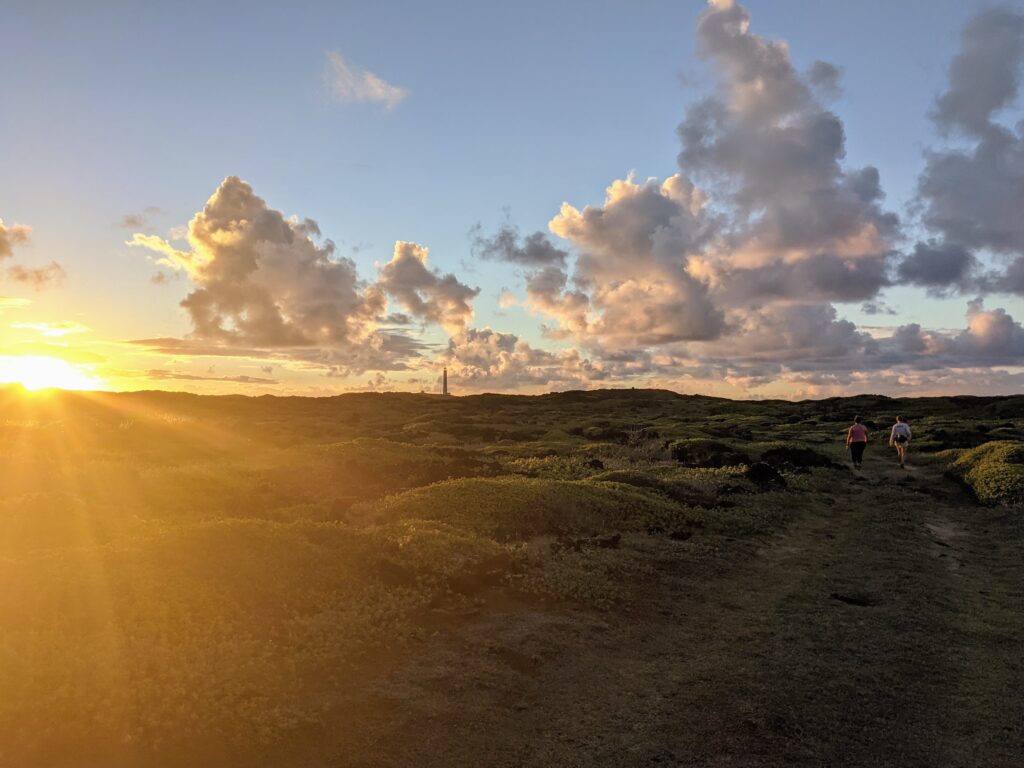
I will remember these Kalaupapa sunsets and evening walks with friends for a long time to come.
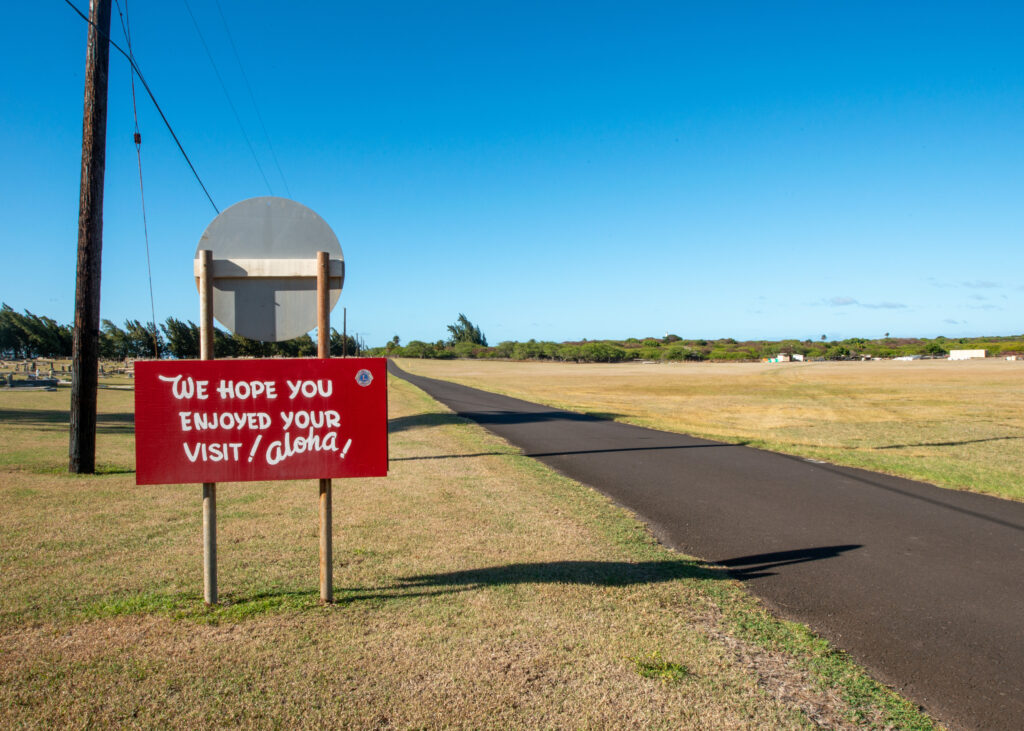


Nicely done, Sarah, interesting read, thank you for sharing your thoughts and experiences.